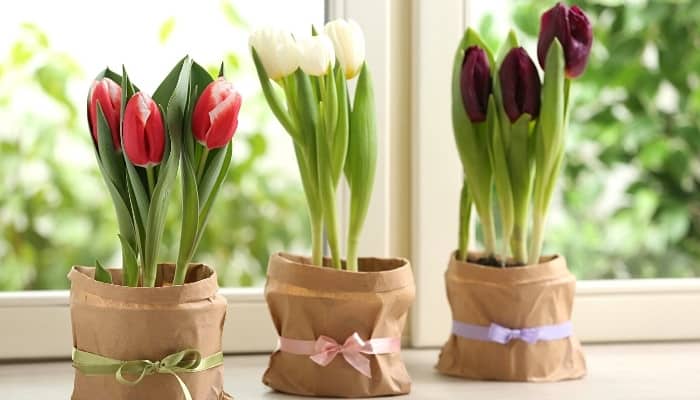Although not commonly viewed as indoor plants, tulips can create stunning arrangements when placed in a vase.
This is because they require a teensy bit more prep compared to most flowering plants, but it is well worth the effort to enjoy these joyous blooms inside.
Tulips can be grown indoors using a process known as vernalization or “forcing,” in which the bulbs are artificially exposed to winter temperatures for several months before being introduced to warmer conditions to simulate the arrival of spring.
In nature, tulip bulbs remain alive in the ground throughout winter and begin sprouting once spring temperatures arrive, which is easier to recreate at home than it sounds!
The following guide will take you step-by-step through the process, plus we’ll go over which varieties work best, care tips, and more.
How To Grow Tulips Indoors
Successful indoor growth is possible using good quality bulbs and correctly “forcing” winter dormancy. After this, it’s a matter of providing the best spring-like growing conditions to help them thrive.
1. Select Varieties Labelled “Good for Forcing” & Prepare Pot
In early October, choose 4 inch+ bulbs from a reputable gardening company that are suited to early blooming, such as ‘Triumph’ or ‘Single Early’.
Then, select a pot 6-8 inches deep and 6 inches wide with drainage holes and fill with a potting mix of 1/3 peat moss, 1/3 potting soil, and 1/3 sand and perlite – leaving 2 inches of space below the rim.
This ensures a soil mix that will drain quickly and discourage conditions that lead to rot and fungal issues.
2. Place Bulbs in Pot, Water & Move to Cool Spot for 12-13 Weeks
Next, place – don’t press – the bulbs in the mix with the tips facing upwards. Add more soil around the bulbs until only the tips are showing, and water the soil thoroughly, letting the excess drain fully.
The bulbs are now ready for a cold treatment of 35-48°F (2-8°C).
Cover the pot with a plastic/paper bag with some breathing holes, and place on a drainage tray in your refrigerator for 12-13 weeks, watering occasionally to keep the mix slightly moist.
Sheila Patel at The National Gardening Association advises keeping the pot away from ripening fruit and vegetables as “these release ethylene gas which can harm the buds.”
3. Remove From Cold When Shoots Appear & Place in Warm Location
After 12-13 weeks, small yellow/pale-green leaves measuring 1-2 inches should appear on the surface.
Acclimatize them to “spring” warmth by placing the growing tulips in a warmer setting of 50-60°F (10-15°C) and sheltered light a few feet from a window for 5-7 days until the shoots turn completely green.
Next, set the pot in/near a bright windowsill and a temperature range of 60-70°F. Rotate the pot daily to ensure even, upright stem development, and anticipate blooming within 3-5 weeks.
Best Tulip Varieties To Grow Indoors
Triumph tulips are popular due to their big blooms, traditional shaping, and color variety. Compact tulips are also ideal as these remain upright without the need for a support stake.
Here are some other low-growing, fast bloomers suited to cold treatment:
- Bright Gem (Tulipa batalinii)
- Red Riding Hood (Tulipa greigii)
- Stresa (Tulipa kaufmanniana)
- White Emperor (Tulipa ‘Purissima‘)
Caring for Indoor Tulips – 3 Tips

1. Water Lightly & Consistently
Tulips are thirsty flowers, so once the growing bulbs are moved out of cold treatment, the soil needs to be watered often to remain slightly moist.
Soggy soil risks rotting the developing roots, so check the soil regularly, and only water when the medium feels dry.
2. Provide Enough Sunlight to Encourage Blooming
Once their shoots become accustomed to warmer temperatures, tulips need bright sun to bloom successfully.
In this period, gardener Marcel Iseli of Plantophiles advises “setting them on your porch, patio, or balcony for a few hours a day to get as much direct sunlight as possible – west-facing gardens are ideal!”
3. Control the Humidity Levels
Tulips perform well in average indoor humidity (40-50%), but air can become extremely dry during the winter, so help them bloom for longer by monitoring your home humidity (this hygrometer is by far the easiest to use and read).
If you find it’s too low, consider using a cool-mist humidifier (like this one that I use with ultra-quiet operation and a rotating nozzle) to release a fine spray of moisture that won’t sit on the growing foliage and risk fungal infection.
What To Do With Indoor Tulips After They Bloom
Prolong the blooms for as long as possible by keeping them cool in filtered sunlight (on a shelf a few feet from a window or in a windowsill with a cloth shade).
Once the blooms fade, deadhead the flowers and allow the foliage to die back before pruning off completely.
The same bulbs won’t have the energy to be forced a second time indoors, but you can store the pot in moderate light and heat until early fall when they can be transplanted outdoors to chill naturally and possibly bloom again.
Related Questions:
Can You Grow Tulips Indoors Year Round?
Yes, as long as you can artificially replicate their seasonal changes of dormancy and sprouting by chilling the bulbs before introducing them to warmer temperatures, growing tulips can be done throughout the year.
After chilling the bulbs in a refrigerator or unheated garage for 12-13 weeks, keep them in a bright, controlled greenhouse climate of 40-60°F (5-15°C).
How Long Do Potted Tulips Last Indoors?
Once tulip bulbs are planted indoors, tulips can take between 8-16 weeks to bloom depending on whether they are potted in the winter or spring.
Once in bloom, potted tulips typically last for a further 15-30 days before dying. Their lifespan may be extended by moving the pot into direct sunlight for a few hours each day.
Conclusion
In summary, tulips can be grown indoors by replicating their natural growing conditions – chilling newly purchased bulbs in a form of hibernation to mimic the wintery ground before exposing them (gradually) to spring-like conditions.
A long blooming period can be possible with a balanced watering schedule and ample sunlight, introduced in careful doses, to replicate the joy of spring flowers in midwinter!
Sources:
https://homeguides.sfgate.com/put-potted-tulip-house-91886.html
https://extension.umn.edu/planting-and-growing-guides/growing-bulbs-indoors

